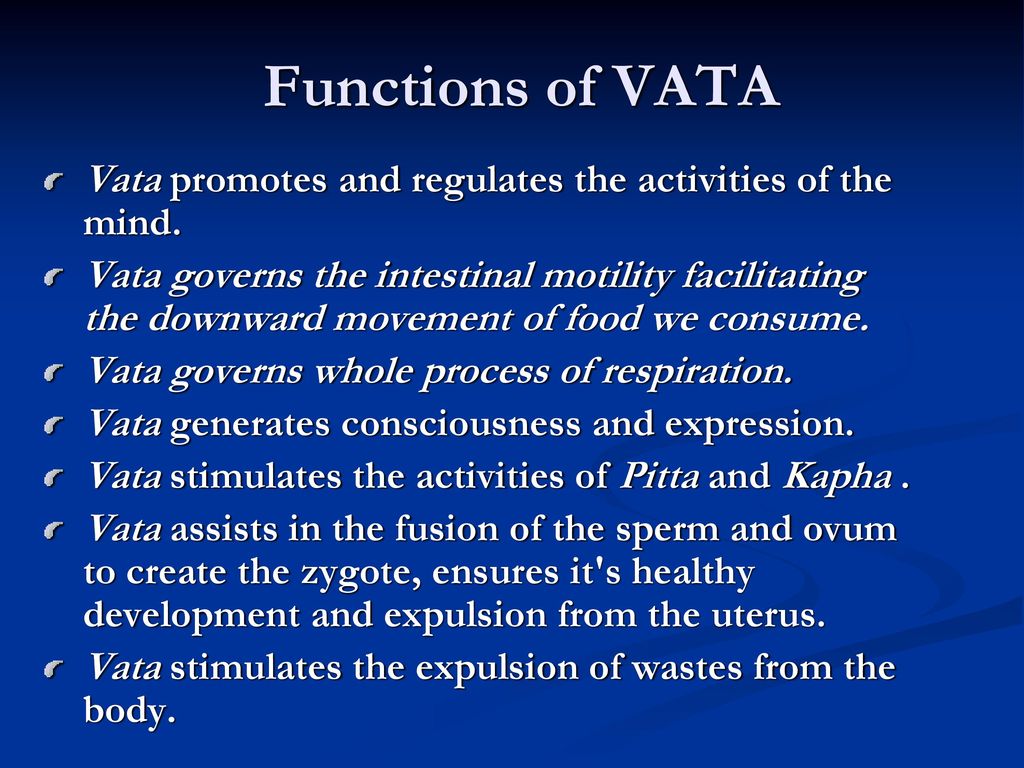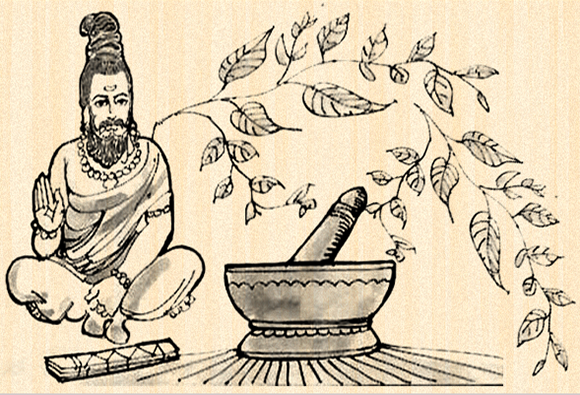
The Ayurvedic Diet
From: Goop.com

Dr. Chandanis a native of Bengaluru in Southern India, and an Ayurvedic Medicine & Surgery graduate. After his bachelors degree, he earned his Post Graduate Certification in Panchakarma from Manipal University in India. He is also certified in yoga by the Bihar School of Yoga. He practiced as a full-time Ayurvedic doctor and Panchakarma specialist in Bangalore for more than 6 years, and managed Ayurvedic clinics and hospitals throughout the country. He has been with Ananda for three years.
Ayurveda & How To Eat For Your Dosha
Ayurveda, which comes from the ancient Vedic texts, is a 5,000-year-old medical philosophy and practice, predicated on the idea that we all are made up of different types of energy.
There are three doshas in Ayurveda, which describe the dominant mind/body state: Vata, Pitta, and Kapha. While all three are present in everyone, Ayurveda proposes that we each have a dominant dosha that’s unwavering from birth, and ideally an equal (though often fluctuating) balance between the other two. When the doshas are balanced, we are healthy; when they are unbalanced, we develop disease, which is usually made manifest by skin issues, poor digestion, insomnia, irritability, and anxiety.
In India, Nepal, and other parts of the East, Ayurveda is considered serious medicine—with schooling that’s commensurate with a Western medical degree. But unlike Western medicine, a basic evaluation goes beyond a physical exam. An Ayurvedic doctor will take your pulse, check your tongue, and assess your appearance (among other factors), and then ask you a series of questions about how you handle and respond to various scenarios. It’s quite cool.
The resident Ayurvedic physician at Ananda, Dr. Chandan, shared some of the basic principles and qualities of the three doshas from Ayurveda, and how to eat for balance; meanwhile, Narendra Sharma, the executive chef behind Ananda’s award-winning wellness kitchen, shared some recipes.
Prakruti
This is the principle that recognizes that each human being is born with unique combinations of doshas, and that this natural balance is what is responsible for physical, mental, and emotional difference among people. By identifying and maintaining an individual’s Prakruti, Ayurveda can help each person create his or her own state of ideal health.
Dosha: Vata
(Air & Space)
Vatas tend to be more spacey, anxious, with active minds. They speak quickly, and are likely to have joints that crack. Vata influences the movement of thoughts, feelings, prana flows, nerve impulses, and fluids in the body.
VATA QUALITIES:
Cold, light, dry, irregular, rough, moving, quick, and always changing. Vata governs movement in the body, the activities of the nervous system, and the process of elimination. Vata influences the other doshas. Vatas tend to always be on the go, with energetic and creative minds. When Vatas are in balance, they are lively and enthusiastic.
PHYSICAL CHARACTERISTICS OF VATA:
Thin, light frame, and excellent adaptability. Their energy comes in bursts, and they are likely to experience sudden bouts of fatigue. Vatas typically have drink skin and cold hands and feet. They sleep lightly and their digestion can be sensitive. When imbalanced, Vatas tend to experience weight loss, constipation, arthritis, weakness, restlessness, aches, and pains.
EMOTIONAL CHARACTERISTICS OF VATA:
Vatas love excitement and new experiences. They are quick to anger but also to forgive. They are energetic, creative, and flexible. They also take initiative and are lively conversationalists. When imbalanced, Vatas are prone to worry, anxiousness, nervousness, and often suffer from insomnia.
When they feel overwhelmed or stressed, their response is: “What did I do wrong?”
HOW VATAS CAN STAY BALANCED:
Follow the dietary guidelines in the diet below:
Maintain a consistent daily routine and keep exercises both gentle and regulated.
Find time for rest and to nurture themselves. Be in a calm, safe, and comforting environment.
Have regular Ayurvedic massages as this is soothing and grounding for Vatas.
Avoid very cold and windy conditions, as well as dry climates.
Minimize travel and too much movement; avoid loud and noisy places as well as crowds and too much talking.
Keep warm and get enough sleep.
FAVORABLE FOODS:
Vata is a cold and dry dosha; warm, nourishing foods with moderately heavy texture, plus added butter and fat are good for stabilizing Vata. Choose salty, sour, and sweet tastes as well as soothing and satisfying foods. Warm milk, cream, butter, warm soups, stews, hot cereals, fresh baked bread, raw nuts, and nut butters are good for Vatas. Take a hot or herbal tea with snacks in the late afternoon. All sweet fruits (so long as they are extra-ripe) are OK for Vata. Warm drinks or hot water are best for Vatas.
Spices: Cinnamon, cardamom, cumin, ginger, cloves, and garlic are all OK for Vatas.
FOODS TO REDUCE:
Cold foods such as salads, iced drinks, raw vegetables and greens are not good for those with Vata imbalance (i.e. where Vata is dominant). Avoid drinks with too much caffeine and candies as they disturb Vata. Avoid unripe fruits, as they are too astringent.
Vata Food Plan:
These guidelines can be used for Vata mind-body constitutions, to maintain dosha balance, and to restore balance if necessary, regardless of the basic constitution.
BEST VEGETABLES (cooked):
Asparagus, beets, carrots, cucumber, garlic, green beans, onions, sweet potatoes, radishes, and turnips.
VEGETABLES IN MODERATION (cooked)
Broccoli, Brussels sprouts, cabbage, cauliflower, celery, eggplant, leafy green vegetables, mushrooms, peas, peppers, potatoes, sprouts, tomatoes, zucchini
Avoid raw vegetables, in general.
BEST FRUITS (well-ripened):
Bananas, apricots, avocados, berries, cherries, coconut, fresh figs, grapefruit, lemons, grapes, mangoes, sweet melons, sour oranges, papaya, pineapple, peaches, plums, stewed fruits.
FRUITS IN MODERATION:
Cranberries, pears, pomegranates.
Avoid dried fruits, in general and all unripe fruit.
BEST GRAINS:
Oats (as cooked oatmeal cereal, not dry), cooked rice.
GRAINS IN MODERATION:
Wheat, barley, buckwheat, corn, dry oat, millet.
DAIRY:
All Dairy is acceptable.
BEST MEAT:
Chicken, seafood, turkey, in small quantity.
MEAT IN MODERATION:
Red meat.
BEST BEANS:
Chickpeas, mung beans, Pink lentils, Tofu (small amounts)
BEANS IN MODERATION:
Kidney beans, black beans, etc.
BEST OILS:
Sesame oil, Ghee and olive oil are especially good.
SWEETENERS:
All sweeteners are acceptable.
NUTS AND SEEDS:
All are acceptable in small amounts. Almonds are best.
HERBS & SPICES:
Avoid using spices in large quantities. Minimize or avoid all bitter and astringent herbs and spices such as coriander seed, fenugreek, parsley, and thyme. Saffron and turmeric should be used in moderation.
Dosha: Pitta
(Fire & Little Water)
Pittas literally have more fire in them than other types. They have better appetites and better digestion. They can withstand the cold better, as they are hotter-headed. They are naturally aggressive and impatient, intelligent, and sharp. Since Pittas have strong and efficient digestion, they can generally eat just about everything. Most Pittas get into trouble by continued use of too much salt, overuse of sour and spicy food, and overeating.
PITTA QUALITIES:
Hot, light, intense, penetrating, pungent, sharp, and acidic. The Pitta dosha controls digestion, metabolism, and energy production. The primary function of Pitta is transformation.
PHYSICAL CHARACTERISTICS OF PITTA:
Pittas have excellent digestion and warm body temperature; they sleep soundly for short periods of time, have abundant energy, and a strong appetite. When imbalanced, Pittas may suffer from skin rashes, burning sensations, peptic ulcers, excessive body heat, heartburn, and indigestion.
EMOTIONAL CHARACTERISTICS OF PITTA:
Pittas have a powerful intellect and a strong ability to concentrate. They are good decision makers, teachers, and speakers. They are precise, sharp-witted, direct, and often outspoken. They are ambitious and practical, and love both adventure and challenges. When imbalanced, Pittas can be short-tempered, argumentative, and suffer outbursts of emotion.
When they feel overwhelmed or stressed, their response is: “What did you do wrong?”
HOW PITTAS CAN STAY BALANCED:
Follow the dietary guidelines in the diet below.
Get plenty of fresh air and choose cooler times of day to get physical exercise.
Keep cool physically and mentally, and apply an attitude of moderation in all things.
Avoid situations of excessive heat, steam, or humidity and take plenty of fluids.
Be considerate and patient with others.
Engage in quiet and contemplative activities.
Avoid situations of potential conflict.
FAVORABLE FOODS:
The best foods for Pittas are cool or warm, with moderately heavy textures—i.e., not steaming hot foods. Bitter, sweet, and astringent tastes are ideal. Take cool, refreshing food in summer or hot weather, like salads, milk, and ice cream. Herbal tea, specifically mint or licorice root tea are pacifying to Pittas. Cold cereal, cinnamon toast, and apple tea is a good breakfast for a Pitta. Vegetarian foods, in general, are the best for Pittas, as consuming red meat tends to heat the body from the fat. They should consume abundant amounts of milk, grains, and vegetables.
FOODS TO REDUCE:
Pittas should use less butter and added fat, and they should avoid pickles, sour cream, and cheese. They should also avoid vinegar in salad dressing and use lemon juice instead. Alcoholic and fermented foods should be avoided. Reduce coffee. Avoid oily, hot, salty, and heavy foods such as anything fried. Pittas should also skip egg yolks, nuts, hot spices, honey, and hot drinks.
Pitta Food Plan:
These guidelines can be used for pitta mind-body constitutions, to maintain dosha balance, and to restore balance if necessary regardless of the basic constitution. Pitta influences digestion and metabolism, body temperature, and biological transformations.
BEST VEGETABLES:
Sweet and bitter vegetables, like asparagus, broccoli, Brussels sprouts, cabbage, radishes, cauliflower, celery, cucumber, green beans, green (sweet) peppers, leafy green vegetables, lettuce, mushrooms, okra, parsley, peas, potatoes, sprouts, squash, sweet potatoes, zucchini, carrot, and spinach.
VEGETABLES IN MODERATION:
Eggplant, onion, tomatoes, hot peppers, chilies, and beets.
BEST FRUITS:
Bananas, avocados, cherries, coconuts, figs, mangoes, melons, oranges, pears, pineapples, plums, prunes, and raisins.
FRUITS IN MODERATION:
Apricot, apples, berries, sour cherries, grapefruit, raw papaya, dark grapes, peaches, persimmon, and pineapples.
Note: Fruits should be sweet and ripe; avoid fruits that come to market sour or unripe. Also avoid green grapes, oranges, pineapple, and plum unless they are sweet and ripe.
FAVORABLE GRAINS:
Barley, oats, wheat, and white rice (preferably basmati).
GRAINS IN MODERATION:
Brown rice, corn, millet, and rye.
BEST DAIRY:
Butter, egg whites, ghee (clarified butter), milk, and fruit sorbets (not sour).
DAIRY IN MODERATION:
Cheese, sour yogurt, sour buttermilk, egg yolk, sour cream, and ice cream.
BEST MEATS:
Chicken, shrimp, turkey, and river fish (all in small amounts).
MEATS IN MODERATION:
Red meat and seafood in general.
BEST BEANS:
Chickpeas, mung beans, red lentils, tofu and other soybean products (not fermented).
BEANS IN MODERATION:
Black gram, black lentils, and Ar har Dal.
BEST OILS:
Olive, soy, sunflower, and grapeseed oil.
OILS IN MODERATION:
Almond, corn, safflower, sesame, and coconut oil.
BEST NUTS & SEEDS:
Coconut, pumpkin seeds, sunflower seeds, flaxseeds.
BEST SWEETENERS:
All are acceptable except honey and molasses.
HERBS AND SPICES:
Spices should generally be avoided as they are too heating. The following are OK for Pittas in small amounts: Cardamom, cilantro (green coriander), cinnamon, coriander seed, dill, fennel, mint, saffron, turmeric, cumin, and black pepper.
Dosha: Kapha
(Earth & Water)
Kaphas tend to have heavier, earthier bodies than other types, and tend to store watery substances like fluids and fat more readily. They are naturally calm and attached; A Kapha speaks slowly and melodically. They sometimes have watery dreams, and tend to have elimination that is thick and heavy.
KAPHA QUALITIES:
Heavy, slow, steady, solid, cold, soft, and oily. Kapha governs the structure of the body. It is the principle that holds the cells together and forms the muscle, fat, bone, and provides immunity. The primary function of Kapha is protection.
Kaphas have a strong build and excellent stamina as well as smooth, radiant skin. They sleep soundly and have regular digestion. But when Kapha build to excess they can gain weight, retain fluid, and allergies manifest in the body. When imbalances, Kaphas may become overweight, sleep excessively, become lethargic, and suffer from asthma, diabetes, and depression.
EMOTIONAL CHARACTERISTICS OF KAPHA:
Kaphas are naturally calm, thoughtful, and loving. They have an inherent ability to enjoy life and are comfortable with routine. Kaphas are strong, loyal, patient, steady, and supportive. They love music, reading, and relaxing. When imbalanced, they tend to hold on to things, jobs, and relationships long after they are no longer present. They display excessive attachment. When imbalanced, Kaphas become stubborn and resist change.
When they feel overwhelmed or stressed, their response is: “I don’t want to be involved.”
HOW KAPHAS CAN STAY BALANCED:
Follow the dietary guidelines in the diet below.
Wake early (before dawn), sleep less, and avoid sleeping during the day.
Indulge in plenty of physical exercise every day.
Perform activities that stimulate and energize the body and mind, and build the metabolic rate.
Allow for excitement, challenge, and variety in life.
Break away from stagnation and clinging to old ways of thinking and behaving.
Keep warm and dry.
FAVORABLE FOODS:
Warm, light, and dry food is favorable, or cooked light meals. Kaphas do best with lightly cooked foods or raw fruits and vegetables. Any food that is spicy is good for Kaphas such as very hot Mexican or Indian food, especially in winter. Dry cooking methods (baking, broiling, grilling, sautéing) are preferable for Kaphas over moist cooking such as steaming, boiling, or poaching. Foods such as romaine lettuce, endive, or tonic water are good for stimulating the Kapha appetite, while preferred spices are cumin, fenugreek, sesame seed, and turmeric.
FOODS TO REDUCE:
Kaphas need to watch the consumption of too many sweet and fatty foods, and need to watch their salt consumption as well, as it can lead to fluid retention. They should avoid deep-fried foods. A typical Kapha tendency is to overeat: The main meal should be at the middle of the day, and only a light, dry meal in the evening. In general, Kaphas should avoid sugar, fats, and dairy products, skip chilled foods and drinks, and use ghee and oils in small amounts only.
Kapha Food Plan:
These guidelines can be used for kapha mind-body constitutions, to maintain dosha balance, and to restore balance if necessary, regardless of the basic constitution. Kapha influences the heavy, moist aspects of the body.
BEST VEGETABLES:
Asparagus, beets, broccoli, Brussels sprouts, cabbage, carrots, cauliflower, celery, eggplant, garlic, leafy green vegetables, lettuce, mushrooms, okra, onions, peas peppers, potatoes, radishes, spinach, and sprouts.
VEGETABLES IN MODERATION:
Cucumbers, sweet potatoes, tomatoes, and zucchini.
BEST FRUITS:
Apples, apricots, berries, cherries, cranberries, papaya, pears, prunes, pomegranates, and grapefruit. Dried fruits in general are good for Kaphas, specifically apricots, figs, prunes, and raisins.
FRUITS IN MODERATION:
Dates, fresh figs, bananas, coconuts, and mangoes.
BEST GRAINS:
Barley, buckwheat, corn, millet, oats, rye, and basmati rice.
GRAINS IN MODERATION:
Rice and wheat.
Avoid hot cereals and steamed grains, in general, as they are too moist and heavy for Kaphas.
BEST DAIRY:
Warm skim milk, small amounts of whole milk, and eggs (not fried or cooked with butter), goat’s milk, soy milk, and camel milk.
DAIRY IN MODERATION:
Egg yolks
BEST MEATS:
Chicken, turkey (all in small amounts), and lean fish.
MEATS IN MODERATION:
Shrimp and red meat.
BEST BEANS:
All legumes are acceptab
le.
BEANS IN MODERATION:
Kidney beans and tofu.
BEST OILS:
Almond, sunflower, olive oil, and grapeseed oil (all in small quantities).
SWEETENERS:
All in very small quantities.
BEST NUTS & SEEDS:
Sunflower seeds, pumpkin seeds, and flax seeds.
HERBS & SPICES:
All are good, especially cumin, fenugreek, sesame, and ginger, which is especially good for improving digestion.
More About Hinduisme
Features
Copyright © 2018 SEAN-O-VISTA

Powered with 





